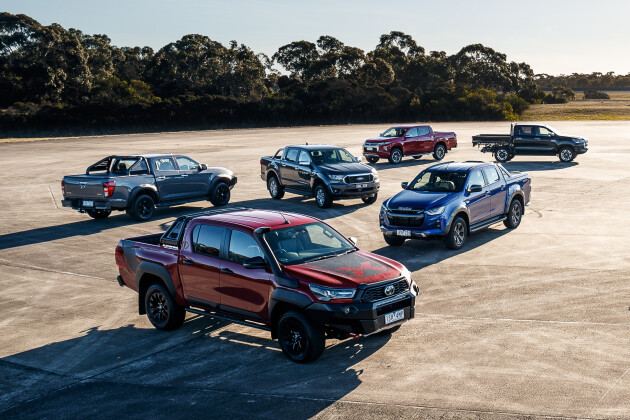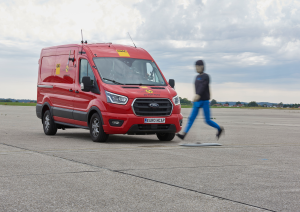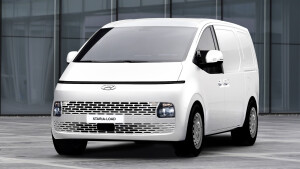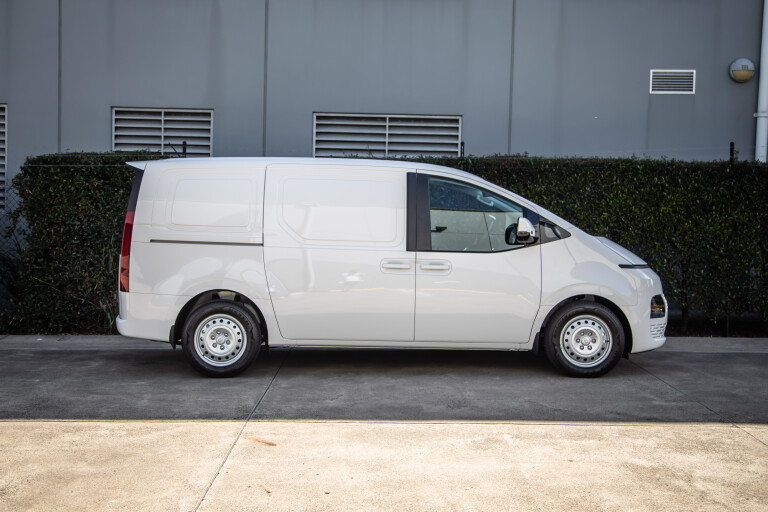Latest Review

First Drive: 2022 Hyundai Staria-Load review
Style, tech and an upmarket spin underpins Hyundai’s reinvented commercial lugger
“Get a Load of that!” Words, one imagines, possibly uttered by onlookers aimed at Staria-Load (geddit?), Hyundai’s fancily reimagined replacement for its now archaic, 14-year-old iLoad.
Minting a humble, fridge white, steel-wheeled commercial van with serious look-at-me factor is no mean feat. And undoubtedly the Korean marque will sell a few examples on futurist schtick alone.
Like it or loathe it – I’ve met a few who do both – this van, draped in forward-thinking style, also promises forward-thinking safety, smarts and convenience as it aims to win back a larger slice of the tradie van market pie. During its purplest patch years back, the iLoad owned 40 per cent market share; in being put to pasture, the outgoing model carved out just 16 per cent, less than half that of the Toyota HiAce (38 per cent).
The newcomer ditches the old iLoad/iMax rear-drive underpinnings for the front-driven F3 family platform shared with Kia Carnival and, of course, the Staria-Load’s people-moving twin. In commercial guise, though, the Staria formula brings a trim choice of two-seat Van or five-seat Crew Van formats, propelled by a sole bum-dragging powertrain based around the 2.2-litre diesel pinched from its Santa Fe SUV cousin.
The Load’s distinctive single-arc silhouette roughly matches a HiAce in dimensions, ostensibly splitting the size difference between Ford Transit Custom SWB and LWB versions, in comparison to its two key nemeses. And its cargo area, larger than iLoad in every measure, covers its rivals’ three-Euro-pallet credentials. But it’s really in safety, comfort and goodies where Staria-Load wants to mark its own territory.
Pricing and Features
The Staria-Load launches as the 2 Seat Van Liftback at $45,740 before on-roads, $2530 up on the outgoing iLoad diesel auto. It’ll be followed by the 5 Seat Crew Cab Liftback (at $48,240 list) in the fourth quarter of this year, when a Twin Swing tailgate option will become available for either body style. Silver paintwork can be optioned for $695.
Hyundai ratifies the bullish pricing with a single trim level bringing some tasty standard equipment inclusions in the areas of tech, assistance and safety.
Outside, the Staria-Load Liftback fits auto dusk-sensing headlights, heated and power-folding mirrors, surround-view camera monitoring with forward viewing, front and rear parking sensors and 17-inch steel wheels with a full-sized spare. Interestingly, the DLR strip featured on the Staria people mover is replaced by a plain black strip on the tradie spec.
But it’s the cabin where the Staria-Load aims to push the usual utilitarian commercial van strip-out more upmarket, centring around the conspicuous inclusion of an LCD instrument cluster and 8.0-inch touchscreen infotainment system featuring wireless Apple CarPlay and Android Auto. The multifunction steering wheel and transmission selector are leather trimmed, while segment firsts include an electric park brake with auto hold and inductive phone charging. While the Hyundai sticks to ol’ faithful key barrel start, the remote entry key fob allows remote power window opening and closing (ala Volkswagen).
Where Hyundai is particularly keen to steal the march over its Ford and Toyota competition is the breadth of safety fit-out.
Its autonomous emergency braking with pedestrian detection includes junction collision avoidance, tech paired with adaptive cruise control that has stop and go functionality. Both the blind-spot and rear cross-traffic monitoring systems feature avoidance/assistance protocols rather than basic alert functionality, and lane-keeping/following smarts, multi-collision braking, intelligent speed limit assist, driver attention warning and safe exit warning are all standard issue. Its seven-airbag fit-out includes a segment-first front centre airbag.
Both the Staria and Staria-Load are currently unrated by ANCAP.
Where Hyundai is particularly keen to steal the march over its Ford and Toyota competition is the breadth of safety fit-out.
Comfort and Space
There’s much to unpack in this Creamy White curvaceous box so let’s start at the all-important business end: cargo.
At 5253mm, Staria-Load is generous in length without causing too many parking headaches. It brings a growth in cargo volume to 4935 litres, up on the old iLoad’s 4426L, with extra measures in its 2607mm (+232mm) of length, 1436mm (+96mm) of height and 1640mm (+20mm) of width. Its load space is a little longer and slightly narrower than its key Ford and Toyota competitors.
The loading height is, at 573mm, 41mm lower than the van it replaces, while the effective side door aperture has grown to 870mm (+225mm) to allow clearance for Euro pallet side-loading.
The standard issue dual side doors are solid and hefty, the somewhat lumpy rubber matted load surface featuring eight floor-mounted anchor points. There are no tie-down locations on the walls but ample screw points to allow fitment. Durable wood particle flooring would make a nice, work-friendly addition.
A mesh-type bulkhead fitted to our test van is certainly sturdy, though the clear plastic zip-tied screen looks a little ad-hoc. The slope of the bulkhead to accommodate seat adjustment up front does eat into the maximum load depth by around 160mm and it’s easy to foul on it loading through the side doors. In short, that improved cargo length is ostensibly only at floor level.
The tailgate is very tall and, when opened, demands a lot of rear clearance. Its two-metre-neat height allows Staria-Load to slip neatly into common (2.1-metre-high) multi-storey car parks, though its stylised roof spoiler could risk clouting the odd low-hanging sprinkler nozzle when opening the tailgate.
Payload capacity is 1072kg, with a GVM of 3020kg due to its portly near-two-tonne (1948kg tare) weighbridge ticket. Braked towing is fairly healthy at 2500kg but offset by a mere 100kg ball load rating, while braked GCM is 5520kg.
Ahead of the bulkhead, it’s a classy rig by load-lugging standards.
Huge, hefty doors with solid handles make for fine first impressions and entry and egress is a breeze. Despite its swooping, thick A-pillars and huge raked windscreen, the cabin is very roomy, with lots of leg and headroom and an exaggerated airiness to the ambience afforded by the massive glass area and low side window sills that form handy outer armrests.
Huge, hefty doors with solid handles make for fine first impressions. Despite its swooping, thick A-pillars and huge raked windscreen, the cabin is very roomy.
It’s not all roses. The lack of fold-down inner armrests on seats is a missed trick that might become annoying during long workdays in the saddle. And the side glass doesn’t fully sink below the sill line, which may annoy some elbow-hanging drivers.
The seating is great, supportive and comfy, with plenty of driver’s height adjustment and lots of under-thigh support, while the handy left-foot dead pedal is positioned perfectly. It has a nice flat floor, too, and the two-seat configuration omits a central storage box so delivery drivers can get easy through-access to the cargo area (when the bulkhead is omitted). Fully carpeted matting, too, is a nice touch.
There’s stowage aplenty. The overhead slots feature a neat elasticized retaining lip, there’s a folder tray on the dash-top (though no lockable cubby), a convenient dash-top driver’s cup holder and retractable passenger-side cradle plus a rubberised key slot/inductive Qi phone charging pad. The door bins are deep and plentiful though the single glovebox, for its part, is tiny.
The dual screen arrangement brings contemporary flash to the otherwise minimalist cabin design, the driver’s display particularly funky with skins that change colour in tandem with the four available drive modes and a tachometer that’s more odd than useful.
More of a mixed bag is the floating touchscreen infotainment unit. Wireless CarPlay is beaut and the rubberised inductive charge tray is a neat pairing, though our test system was plagued with chronic drop-out issues. Not exactly the thing you need on a delivery job on the clock when your phone-sourced sat-nav fails and there’s no proprietary navigation as backup. Similarly, why no DAB+ digital radio?
But the camera system is excellent, particularly the forward view. Meanwhile, the split rear and overhead viewing can be switched to individual viewing angles, including kerb-side and overhead ‘bumper cam’. Rounding out conveniences are dual USB ports and a 12-volt outlet.
On the Road
The one-spec-fits-all engine is, in Hyundai’s words, the tried and true “Sante Fe” unit, a 2.2-litre turbodiesel producing 130kW at 3800rpm and a surly 430Nm between 1500-2500rpm that outpunches the torque credentials of the Staria people-mover’s standard petrol V6. No on-demand all-wheel drive here, though, as the Staria-Load is only available in front-drive paired with a conventional eight-speed automatic transmission.
It’s quite a refined powertrain, with subdued diesel chatter and impressive slickness to the transmission. Unladen, there’s ample enthusiasm in the Staria-Load’s step, with plenty of on-tap torque without much sense of strain under load. Nor is there much in the way of lag in response or overt laziness in the default Comfort drive mode, though the transmission does like to hunt about a little if faced with a decent incline in the road.
There’s muscle enough in that, generally, the diesel ticks over without fuss and at a leisurely clip, our test van returned neat eight-litre consumption (unladen) off the back of a 7.0L/100km combined claim.
As the joke goes, the fastest vehicle on the road is always a delivery van and Sport mode does inject just the right amount of enthusiasm for busy couriers in a rush. There’s also Eco and Smart, if for unnecessary completeness rather than any pressing effect.
The switch to front-drive doesn’t seem to affect driveability, at least during the dry running we experienced on test. No torque steer, no traction issues, no worries. The steering is, at 3.4 turns, a little slow and demands a lot of arm movement with low-speed maneuvering, but it’s clear, direct and pleasingly light in assistance. The Staria-Load also presents an impressively concise turning circle when required.
It is, wholly, an easy and pleasant thing to drive, cooperative in manner and fairly easy to judge in tight spaces given its expansive outward visibility and suite of assistance systems. On that, the lane keeping/tracing smarts do get overbearing at urban speeds, forcing you to dive for off button at every start-up.
The core comfort afforded by its cabin design and ergonomics makes the Staria-Load a nice place to spend the work-a-day hours. That said, the ride is tuned more for load-lugging than sheer pleasure and its slightly fiddly nature, particularly unladen, can become a little tiresome.
On balance, it’s a fairly quiet operator, the powertrain acceptably muted and causing little in way of sonic reverberation throughout its boxy metallic structure despite our tester only having the flimsy plastic bulkhead sheet as sound deadening between the cabin and cargo spaces. The sheer solidity of the thing, too, means there are few of the squeaks and rattles that commonly afflict the tradie van set.
The core comfort afforded by its cabin design and ergonomics makes the Staria-Load a nice place to spend the work-a-day hours.
Ownership
The Staria-Load is covered by a five-year/160,000km warranty, be it for commercial or private use. Hyundai’s capped-price servicing is $360 per 12-month/15,000km visit for the first five years.
Verdict
Appearances apart, the Staria-Load feels like a smarter, nicer, more evolved commercial appliance. That said, beyond moving the goalposts in expectations of standard-fitment safety equipment, it’s not the vanning revolution its stylised form might otherwise suggest. And there are certainly areas that could be better or somewhat improved.
As a load-lugger, it doesn’t really move the game forward a whole lot. But the added feel-good factor, inherent comfort and user-friendliness do pay dividends in the day-to-day experience.
2021 Hyundai Staria-Load specifications
Score breakdown
Things we like
- It’s a beaut looking rig
- Smart, spacious cabin with upmarket touches
- Mostly polished on-road experience
Not so much
- Basic infotainment features
- Apple CarPlay drop-outs
- Bulkhead encroaches on cargo area depth
News
-
 News
NewsEOFY 2022: Best deals on utes and vans
Looking for a good deal this EOFY season? Look no further – we've found you all the latest commercial vehicle offers
-
 News
NewsANCAP reveals van safety comparison for 2022
More poor results for Mitsubishi and Renault's commercial offerings
-
 News
News2021 Hyundai Staria and Staria-Load receive five-star ANCAP rating
Both passenger and commercial variants score top marks
-
 News
NewsHyundai reveals pricing and features of 2022 Staria-Load
New Hyundai van aims to win back buyers in the commercial segment
-

Hyundai Staria-Load set to replace iLoad van


